Ybor City
Ybor City (/ˈiːbɔːr/ EE-bor)[1] is a historic neighborhood in Tampa, Florida, United States, located just northeast of downtown. It was founded in the 1880s by Vicente Martinez-Ybor and other cigar manufacturers and was populated by thousands of immigrants, mainly from Cuba, Spain, and Italy. For the next 50 years, workers in Ybor City's cigar factories rolled hundreds of millions of cigars annually.
Ybor City | |
|---|---|
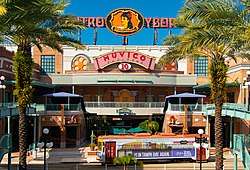 Centro Ybor complex with a TECO Line car passing in front | |
| Nickname(s): Florida's Latin Quarter | |
 Ybor City | |
| Coordinates: 27°57′41″N 82°26′42″W | |
| Country | United States |
| State | Florida |
| County | Hillsborough County |
| City | Tampa |
| Founded | 1885 |
| Incorporation into Tampa | 1887 |
| Time zone | UTC-5 (EST) |
| • Summer (DST) | UTC-4 (EDT) |
| Website | https://www.yborcityonline.com/ |
Ybor City was unique in the American South as a successful town almost entirely populated and owned by immigrants. The neighborhood had features unusual among contemporary communities in the south, most notably its multi-ethnic and multi-racial population and their many mutual aid societies. The cigar industry employed thousands of well-paid workers, helping Tampa grow from an economically depressed village to a bustling city in about 20 years and giving it the nickname "Cigar City".[2]
Ybor City grew and flourished from the 1890s until the Great Depression of the 1930s, when a drop in demand for fine cigars reduced the number of cigar factories and mechanization in the cigar industry greatly reduced employment opportunities in the neighborhood. This process accelerated after World War II, and a steady exodus of residents and businesses continued until large areas of the formerly vibrant neighborhood were virtually abandoned by the late 1970s. Attempts at redevelopment failed until the 1980s, when an influx of artists began a slow process of gentrification. In the 1990s and early 2000s, a portion of the original neighborhood around 7th Avenue developed into a night club and entertainment district, and many old buildings were renovated for new uses. Since then, the area's economy has diversified with more offices and residences, and the population has shown notable growth for the first time in over half a century.
Ybor City has been designated as a National Historic Landmark District, and several structures in the area are listed in the National Register of Historic Places. In 2008, 7th Avenue, the main commercial thoroughfare in Ybor City, was recognized as one of the "10 Great Streets in America" by the American Planning Association.[3] In 2010 Columbia Restaurant was named a "Top 50 All-American icon" by Nation's Restaurant News magazine.[4]
History
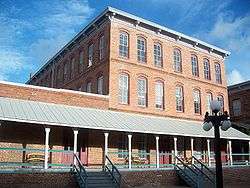
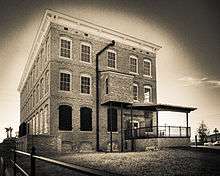
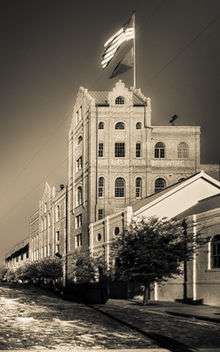
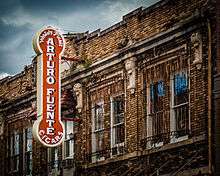
Establishment
In the early 1880s, Tampa was an isolated village with a population of less than 1000 and a struggling economy.[5] However, its combination of a good port, Henry Plant's new railroad line, and humid climate attracted the attention of Vicente Martinez Ybor, a prominent Spanish cigar manufacturer.[6]
Ybor had moved his cigar-making operation from Cuba to Key West, Florida, in 1869, due to political turmoil in the then-Spanish colony. But, labor unrest and the lack of room for expansion had him looking for another base of operations, preferably in his own company town.[7]
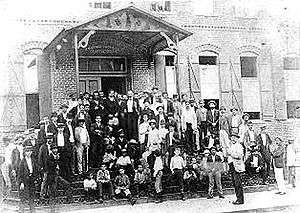
Ybor considered several communities in the southern United States and decided that an area of sandy scrubland just northeast of Tampa would be the best location. In 1885, the Tampa Board of Trade helped broker an initial purchase of 40 acres (160,000 m2) of land, and Ybor quickly bought more.[7] However, Ybor City very nearly didn't happen at all. Vicente Ybor initially failed to come to an agreement with the owner of the 40 acre parcel. The Tampa Board of Trade was horrified to find that the purchase had failed and hatched a plan to get the buyer and seller back together. Vicente Ybor was sitting in the train station on his way to Jacksonville to look at more property when the Board of Trade (a group of five, one of whom was Frederick Salomonson, future 3-time mayor of Tampa) arrived and persuaded Ybor to reconsider and the deal went forward from there, the birth of Ybor City.
Cigar making was a specialized trade, and Tampa did not possess a workforce able to man the new factories. To attract employees, Ybor built hundreds of small houses for the coming influx of mainly Cuban and Spanish cigar workers, many of whom followed him from Key West and Cuba. Other cigar manufacturers, drawn by incentives provided by Ybor to further increase the labor pool, also moved in, quickly making Tampa a major cigar production center.[8]
Italians were also among the early settlers of Ybor City. Most of them came from a few villages in southwestern Sicily. The villages were Santo Stefano Quisquina,[9] Alessandria della Rocca, Bivona, Cianciana, and Contessa Entellina.[10] Sixty percent of them came from Santo Stefano Quisquina.[11] Before settling in Ybor City, many first worked in the sugar cane plantations in St. Cloud, central Florida. Some came by way of Louisiana.[12] A number of families migrated from New Orleans after the lynching of eleven Italians in 1891 during the "Mafia Riot".[13] Italians mostly brought their entire families with them, unlike other immigrants.[13] The foreign-born Italian population of Tampa grew from 56 in 1890 to 2,684 in 1940.[14] Once arriving in Ybor City, Italians settled mainly in the eastern and southern fringes of the city. The area was referred to as La Pachata, after a Cuban rent collector in that area. It was also called "Little Italy".[14]
Unlike Cubans and Spaniards, the Italians arrived in the cigar town without cigar-making skills. When the early Italians entered the factories, it was at the bottom of the ladder, positions which did not involve handling tobacco. Working beside unskilled Cubans, mainly Afro-Cubans, they swept and hauled and were porters and doorkeepers. In time, many did become cigar workers, including Italian women. The majority of the Italian women worked as cigar strippers in 1900, an undesirable position mainly held by women who could find nothing else. However, eventually many of them became skilled cigar makers, earning more than the male Italian cigar makers. Other Italian immigrants started small businesses built around the cigar industry, such as cafés, food stores, restaurants, and boardinghouses.[14]
The least known of the immigrants that came to Ybor City are the Germans,[15] the Romanian Jews, and the Chinese. The Chinese and Jews were employed mainly in service trades and retail businesses.[16] The Germans arrived after the 1890s, and most were businessmen. In the cigar factories, they worked as managers, bookkeepers, and supervisors. Cigar boxes were made by German-owned factories. Several early cigar box labels were made by German lithographers. The Germans formed their own club, the Deutsch Amerikanischer Verein. The club building is still standing on Nebraska and 11th Avenue. It contained a restaurant open to the public that served German food. In 1919, because of anti-German feelings from World War I, they sold the building to the Young Men's Hebrew Association. The building is now used as offices for the City of Tampa.[17]
In 1887, Tampa annexed the neighborhood. By 1900, the rough frontier settlement of wooden buildings and sandy streets had been transformed into a bustling town with brick buildings and streets, a streetcar line, and many social and cultural opportunities. Largely due to the growth of Ybor City, Tampa's population had jumped to almost 16,000.[18]
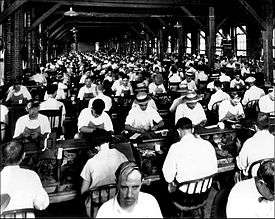
The Golden age
Ybor City grew and prospered during the first decades of the 20th Century. Thousands of residents built a community that combined Cuban, Spanish, Italian, and Jewish culture. "Ybor City is Tampa's Spanish India," observed a visitor to the area, "What a colorful, screaming, shrill, and turbulent world." [19]
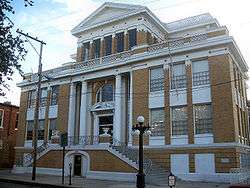
An aspect of life were the mutual aid societies built and sustained mainly by ordinary citizens. These clubs were founded in Ybor's early days (the first was the Centro Español, established in 1891) and were run on dues collected from their members, usually 5% of a member's salary. In exchange, members and their whole family received services including free libraries, educational programs, sports teams, restaurants, numerous social functions like dances and picnics, and free medical services. Beyond the services, these clubs served as extended families and communal gathering places for generations of Ybor's citizens.
There were clubs for each ethnic division in the community – the Deutscher-Americaner Club (for German and eastern Europeans), L'Unione Italiana (for Italians), El Circulo Cubano (for light-skinned Cubans), La Union Marti-Maceo (for darker-skinned Cubans), El Centro Español (for Spaniards), and the largest, El Centro Asturiano, which accepted members from any ethnic group[20]
Although there was little racism in Ybor City, Tampa's Jim Crow laws at the time forbade Afro-Cubans from belonging to the same social organization as their lighter-skinned countrymen. Sometimes, differences in skin color within the same family made joining the same Cuban club impossible.[21] In general, the rivalries between all the clubs were friendly, and families were known to switch affiliations depending on which one offered preferred services and events.
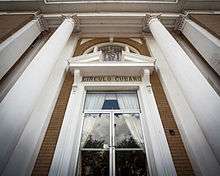
Cigar production reached its peak in 1929, when 500 million cigars were rolled in the factories of Ybor City.[22] Not coincidentally, that was also the year that the Great Depression began.
Decline and rebirth
The Depression was a major blow to cigar manufacturers. Worldwide demand plummeted as consumers sought to cut costs by switching to less-expensive cigarettes, and factories responded by laying off workers or shutting down. This trend continued throughout the 1930s as the remaining cigar factories gradually switched from traditional hand-rolled manufacturing to cheaper mechanized methods, further reducing the number of jobs and the salaries paid to workers.[23]
After World War II, many returning veterans chose to leave Ybor City due to a lack of well-paying jobs and a US Veterans Administration home loan program that was only applicable to new homes, of which there were few in the neighborhood. In fact, the home stock was aging poorly, as many of the structures built in the early days of Ybor City were still in use.[24]
As the historic neighborhood continued to empty out and deteriorate through the 1950s and 1960s, the federal Urban Renewal program sought to revitalize the area by demolishing older structures and encouraging new residential and commercial development. The demolition took place, but due to a lack of funds, the redevelopment did not happen. The primary legacy of the program was blocks of vacant lots which remained empty for decades. The construction of Interstate 4 through the center of the neighborhood during this period also resulted in the destruction of many buildings and cut most of the north–south routes through the area.[23]
By the early 1970s, very few businesses and residents remained, most notably the Columbia Restaurant and a few other businesses along 7th Avenue.[25]
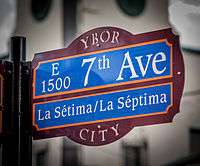 7th Ave Sign in Ybor City
7th Ave Sign in Ybor City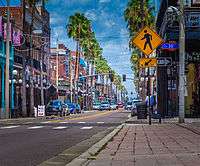 7th Ave Ybor City
7th Ave Ybor City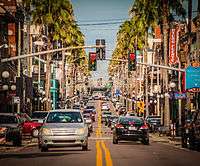 Traffic in Ybor City
Traffic in Ybor City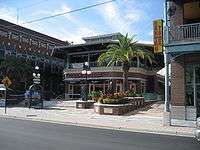 Centro Ybor, a restored shopping area on 7th Ave
Centro Ybor, a restored shopping area on 7th Ave
Recovery
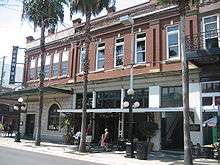
In the early 1980s, an influx of artists seeking interesting and inexpensive studio quarters started a slow recovery, followed by a period of commercial gentrification.[26][27] By the early 1990s, many of the old long-empty brick buildings on 7th Avenue had been converted into bars, restaurants, nightclubs, and other nightlife attractions.[28] Traffic grew so much that the city built parking garages and closed 7th Ave. to traffic to deal with the visitors.
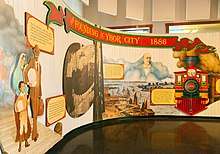
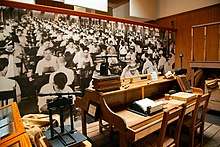
Since around 2000, the city of Tampa and the Ybor City Chamber of Commerce have encouraged a broader emphasis in development. With financial help from the city, Centro Ybor, a family-oriented shopping complex and movie theater, opened in the former home of the Centro Español social club. New apartments, condominiums and a hotel have been built on long-vacant lots, and old buildings have been restored and converted into residences and hotels. New residents began moving into Ybor City for the first time in many years.[29] The blocks surrounding 7th Avenue also thrive with restaurants, nightlife and shopping.[30][31] Reflecting the district's status as a party destination, Ybor City is referenced extensively in the lyrics of Brooklyn-based rock band The Hold Steady. The song "Killer Parties", for instance, contains the line "Ybor City is très speedy, but they throw such killer parties."[32] In May 2009 Swedish super-retailer IKEA opened its long-awaited Tampa location in the southern edge of Ybor City.[33]
The local museum is the Ybor City Museum State Park in the former Ferlita Bakery building (originally La Joven Francesca) building on 9th Avenue. Tours of the gardens and the "casitas" (small homes of cigar company workers) are provided by a ranger. Exhibits, period photos and a video cover the founding of Ybor City and the cigar making industry.[34]
Boundaries
Historically, the boundaries of "Greater Ybor City" stretched from Tampa Bay on the south to Dr. Martin Luther King Jr. Blvd. (formerly Buffalo Avenue) on the north, and from Nebraska Avenue on the west to 40th Street on the east.[22] This eventually included all of today's neighborhoods of Historic Ybor, East Ybor, VM Ybor, and Ybor Heights plus a portion of East Tampa. The Ybor City Historic District encompasses the central portion of that area, approximately straddling Interstate 4, which bisected the neighborhood in the 1960s.[35]
The official boundaries of the Historic Ybor neighborhood are I-4 to the north, 22nd Street to the east, Adamo Drive to the south, and Nebraska Avenue to the west.[36] The area of this district is about 1 square mile (about 2.6 km2). Though modern Ybor City also includes some of the surrounding area, its exact dimensions are loosely defined and subject to debate.[37]
Population
At the height of its life as a thriving immigrant community, Ybor City's population was numbered in the tens of thousands. In the lowest point in the late 1970s, perhaps 1000 residents called the neighborhood home.[22]
In recent years, the numbers have begun to climb once more. Ybor City's population grew an estimated 42.5% between 2000 and 2003, mainly as a result of new condominium and apartment construction. As of 2003, approximately 2,900 residents lived in the area.[29]
Economy and land use
Ybor City is one of the oldest sections of Tampa and is almost entirely an urban, built-up area. Commercial property comprises almost 50% of the land, institutional use (including the Hillsborough County Sheriff's Operations Center and a satellite campus of Hillsborough Community College) 16%, residential use about 23%, and industrial use about 7% [38]
According to a 2003 survey, the top five business types in the area were professional services (22.8%), retail (18.4%), manufacturing (14.0%), wholesale/distribution (13.2%), and restaurants & bars (11.4%).[29]
Transportation
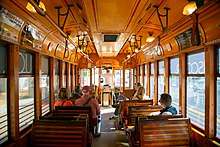
For the most part, Ybor City still uses the gridded street system laid out by Gavino Guiterrez in 1885. Many roadways are now paved with modern materials, though a few brick streets remain.
Because 21st and 22nd Streets, which cut north–south through the area, were once the main traffic routes between Interstate 4 and the Port of Tampa Bay, there was a large volume of semi-trailer truck traffic funneling through the historic district for many years. This caused damage to narrow city roads, was a danger to pedestrians, and sometimes resulted in trucks colliding with historic buildings.[39] In 2014, the elevated I-4/Selmon Expressway Connector was built to siphon heavy truck traffic away from the historic district.[40]
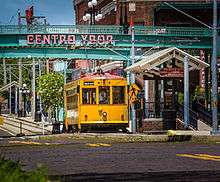
The TECO Line Streetcar, which links Ybor City, the Channelside District and Downtown Tampa, began operating in October 2002. The Hillsborough Area Regional Transit Authority (HARTline) operates the streetcars as well as the bus system. Small startups have also begun utilizing NEVs to shuttle passengers between Tampa's core neighborhoods including Ybor.[41]
Museums
- Cigar Museum And Visitor Center, Ybor City
- Ybor City Museum State Park
- TECO Line Streetcar Museum
Annual events
- Sant'Yago Knight Parade (sometimes known as Gasparilla Night Parade) - usually held two weeks after the Gasparilla Pirate Festival in mid to late February
- Guavaween - daytime events and nighttime parade in October, named for Tampa's "The Big Guava" nickname
Notable people
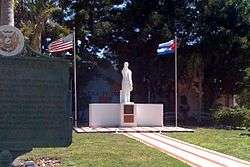
- Braulio Alonso, first Hispanic president of the National Education Association
- Dick Greco, multi-term mayor of Tampa
- Marcelino Huerta, College Football Hall of Fame coach
- KJ-52, influential Christian hip-hop artist, whose debut album was named 7th Avenue after Ybor City's main commercial street
- Joe Lala, musician and actor
- Victor Licata, axe murderer whose 1933 killings influenced the idea that marijuana causes criminal insanity
- Al López, first Tampa native to play Major League Baseball, manage a major league team, and be inducted into the Baseball Hall of Fame
- Baldomero Lopez, Medal of Honor recipient during the Korean War
- Nick Nuccio, first Italian mayor of Tampa
- Ferdie Pacheco, boxing personality, artist, and author
- Frank Ragano, "mob lawyer", author
- Santo Trafficante Sr. and Jr., alleged Mafia bosses
- Jose Yglesias, author
- Cesar Gonzmart concert violinist and entertainer, Spanish "nobleman" and energetic chairman of the $42 million Columbia Restaurant Group
In popular culture
Music
- Jason Isbell references Ybor City in the song "Traveling Alone" from the album Southeastern released in 2013.
- The Hold Steady also reference Ybor City in several of their songs. Some examples are "Killer Parties", "Slapped Actress", "The Cattle And The Creeping Things" and "Most People are DJs".
- JJ Grey & MOFRO references Ybor City in a song of that title on their album Orange Blossoms.
Literature
- Ybor City natives Jose Yglesias and Ferdie Pacheco have each written several books and stories set in their hometown. Most notably, Yglesias' debut novel is entitled A Wake in Ybor City, while Pacheco's memoir of his early life is called Ybor City Chronicles.
- Anna in the Tropics, the winner of the 2003 Pulitzer Prize for Drama written by Nilo Cruz, is set in the cigar factories of Ybor City.
- Ybor City and Tampa are prominently featured in the novels Live by Night and its sequel World Gone By by Dennis Lehane.
- Ybor City and the greater Tampa Bay area is the setting for the novel Only Dangerous In The Breeding Season by John Callaghan.
Film
- The 2016 film Live by Night (based on the books of Dennis Lehane) is centered on an Ybor City bootlegger who becomes a notorious gangster during Prohibition. The crime drama was written, directed, and co-produced by Ben Affleck, who also played the starring role. Although the movie is almost entirely set in Tampa during the early 1930s, much of it was shot in and around Brunswick, Georgia due to movie production tax incentives offered by the state of Georgia and the town's proximity to Affleck's home. Ybor City-inspired signage and decorations were added to buildings in downtown Brunswick, and several new buildings based on locations in Tampa were constructed on empty lots to add to the "fake Ybor City" setting.[42]
Television
- In 2016, the Ad Council and the non-profit Love Has No Labels produced a public service announcement promoting diversity and inclusion starring John Cena that used Ybor City as a backdrop for a commercial which premiered on July 4, 2016 to coincide with Pride Month. The PSA promotes the importance of acceptance of all communities, regardless of race, religion, gender, sexual orientation, age and ability.[43]
See also
- Channelside
- Downtown Tampa
- Hyde Park
- SoHo
- Tampa Heights, historic neighborhood bordered to the northwest
- West Tampa, historic district a few miles northwest with similar Cuban roots.
References
- "Ybor City". Oxford Dictionaries. Oxford University Press. Retrieved October 28, 2015.
- "Determining the Facts: The History of Ybor City". nps.gov. Retrieved 2015-10-28.
- "Historical 7th Avenue in Ybor City recognized". Tampa Bay Business Journal. 2008-10-08. Retrieved 2008-12-26.
- http://www.nationsrestaurantnews-digital.com/nationsrestaurantnews/20100125/?pg=3#pg5 Archived 2010-02-03 at the Wayback Machine
- Mormino&Pizzo, Ch. 9
- "Cigar Heritage". Yborcityonline.com. Retrieved 2015-10-28.
- "Research | Ybor City Museum". Ybormuseum.org. Archived from the original on December 9, 2008. Retrieved 2008-12-26.
- "Park Summary for Print - Ybor City Museum State Park". Florida State Parks. 2003-12-05. Retrieved 2010-01-18.
- Gary R. Mormino and George E. Possetta, The Immigrant World of Ybor City, Italians and Their Neighbors in Tampa, 1885-1985 (Gainesville: University Press of Florida, 1998), 9.
- Frank Trebín Lastra, Ybor City, The Making of A Landmark Town (Tampa, Florida: University of Tampa Press, 2006), 64.
- Mormino and Possetta, The Immigrant World of Ybor City, 9.
- Lasta, Ybor City, 64, 74, 73.
- Mormino and Possetta, The Immigrant World of Ybor City, 82.
- Mormino and Possetta, The Immigrant World of Ybor City, 55.
- Mormino and Possetta, The Immigrant World of Ybor City, 99, 101, 106, 86.
- "Ybor City: Cigar Capital of the World". National Park Service: accessed December 29, 2016.
- Lasta, Ybor City, 85–88.
- Mormino&Pizzo, p. 130
- Mormino&Pizzo, p. 96
- Halstead, Larry (2008-06-06). "Ybor City's cultural clubs, icons of heritage in peril - Tampa Bay Business Journal:". Bizjournals.com. Retrieved 2008-12-26.
- "The Afro-Cuban Community in Ybor City and Tampa, 1886-1910 | Nancy Raquel Mirabel | OAH Magazine of History". Oah.org. Archived from the original on 2008-06-30. Retrieved 2008-12-26.
- Lastra
- "Ybor City: Cigar Capital of the World-Reading 1". Nps.gov. Retrieved 2008-12-26.
- "'Cigar City'". Southtampa2.tbo.com. 2008-08-31. Retrieved 2008-12-26.
- "Florida: Ybor City Historical Site (Local Legacies: Celebrating Community Roots - Library of Congress)". Lcweb2.loc.gov. Retrieved 2008-12-26.
- "Jack Boulware " Archive " Cigar Overdose in Ybor City". Jackboulware.com. Retrieved 2008-12-26.
- Jamison, Gayla (Producer, Director, Writer) (1987). Living in America: 100 Years of Ybor City (video documentary). Tampa, Fl: Lightfoot Films, Inc.
- Seizing The Day Archived 2008-04-14 at the Wayback Machine, The Tampa Tribune, March 27, 2005.
- "Executive Summary" (PDF). Retrieved 2008-12-26.
- Price, Cindy (December 9, 2005). "36 Hours in Tampa, Fla". New York Times.
- The A-to-Z Hold Steady Glossary from the Washington Post
- "Ikea To Open Ybor City Store In May". .tbo.com. 2009-03-05. Retrieved 2010-01-18.
- Visit the Museum
- "K:\GMDS Historic Preservation\HPC Functions\A AutoCAD Historic District Maps\Original Maps\Current District Maps\yborhist_exp 1" (PDF). Archived from the original (PDF) on 2010-06-12. Retrieved 2008-12-26.
- "Tampa Neighborhoods". The City of Tampa / tampagov.net. Retrieved 2019-10-23.
- "Citytimes: Not in Ybor City". Sptimes.com. Retrieved 2008-12-26.
- "Ybor City hopes connector will ease traffic woes - St. Petersburg Times". Tampabay.com. Retrieved 2010-01-18.
- "I-4 connector work to begin in January | Preview video - St. Petersburg Times". Tampabay.com. Retrieved 2010-01-18.
- "Archived copy". Archived from the original on 2012-12-09. Retrieved 2009-07-17.CS1 maint: archived copy as title (link)
- Guzzo, Paul (September 29, 2015). "Fake Ybor City rising in Georgia for Affleck's Prohibition-era film". TBO.com. Retrieved August 6, 2017.
- "We Are America ft. John Cena, Love Has No Labels, Ad Council". YouTube.com. July 4, 2016. Retrieved July 4, 2016.
Bibliography
- Espinosa, Jack (2008). Cuban Bread Crumbs. Xlibris Corporation. ISBN 978-1-4257-9678-5.
- Tampa Bay History Center (2003). Hillsborough's Communities. Tampa Bay History Center. ISBN 1-930148-07-0.
- Ingalls, Robert (2003). Tampa Cigar Workers: A Pictorial History. Gainesville, Fla.: University Press of Florida. ISBN 0-8130-2602-4.
- Lastra, Frank (2006). Ybor City: The Making of a Landmark Town. University of Tampa Press. ISBN 1-59732-003-X.
- Mormino, Gary (1998). The Immigrant World of Ybor City. Gainesville, Fla.: University Press of Florida. ISBN 0-8130-1630-4.
- Mormino, Gary; Tony Pizzo (1983). Tampa The Treasure City. Tulsa, OK: Continental Heritage Press. ISBN 0-932986-38-2.
- Muniz, Jose Rivero (1976) [1954]. The Ybor City Story: 1885-1954. translated by E. Fernandez and H. Beltran. private printing.
- Pacheco, Ferdie (1994). Ybor City Chronicles. Gainesville, Fla.: University Press of Florida. ISBN 0-8130-1296-1.
- Westfall, Loy G. (2000). Tampa Bay: Cradle of Cuban Liberty. Key West Cigar City USA. ISBN 978-0966894820.
External links
| Wikimedia Commons has media related to Ybor City. |
- Burgert Brothers Ybor Collection An interactive map of Ybor City where historic photos were taken by the Burgert Brothers.
- Ybor City Development Corporation
- Ybor City Chamber of Commerce
- La Gaceta newspaper
- “Ybor City: Cigar Capital of the World”, a National Park Service Teaching with Historic Places (TwHP) lesson plan
- University of South Florida Libraries: The Columbia Restaurant & Gonzmart Family Collection, 1903-
- "Preserving the Memory of Ybor City, Florida", Southern Spaces, 22 December 2009.
